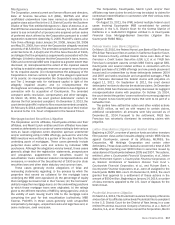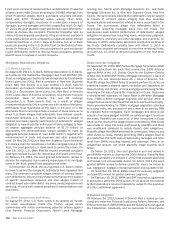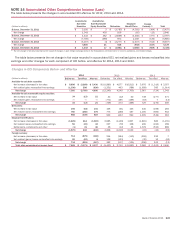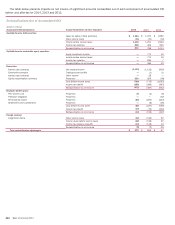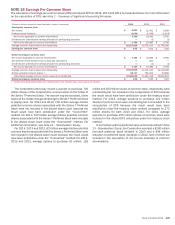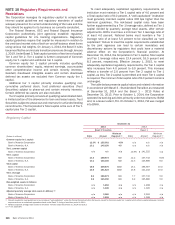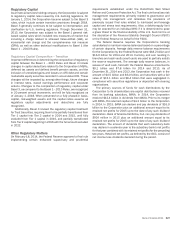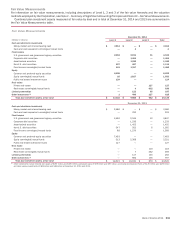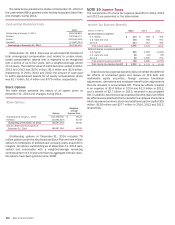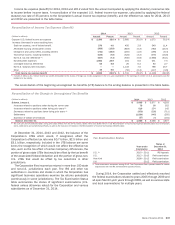Bank of America 2014 Annual Report Download - page 229
Download and view the complete annual report
Please find page 229 of the 2014 Bank of America annual report below. You can navigate through the pages in the report by either clicking on the pages listed below, or by using the keyword search tool below to find specific information within the annual report.Bank of America 2014 227
Regulatory Capital
As a financial services holding company, the Corporation is subject
to regulatory capital rules issued by U.S. banking regulators. On
January 1, 2014, the Corporation became subject to the Basel 3
rules, which include certain transition provisions through 2018.
Basel 3 generally continues to be subject to interpretation and
clarification by U.S. banking regulators. Through December 31,
2013, the Corporation was subject to the Basel 1 general risk-
based capital rules which included new measures of market risk
including a charge related to stressed Value-at-Risk (VaR), an
incremental risk charge and the comprehensive risk measure
(CRM), as well as other technical modifications to Basel 1 (the
Basel 1 – 2013 Rules).
Regulatory Capital Composition – Transition
Important differences in determining the composition of regulatory
capital between the Basel 1 – 2013 Rules and Basel 3 include
changes in capital deductions related to the Corporation’s MSRs,
deferred tax assets and defined benefit pension assets, and the
inclusion of unrealized gains and losses on AFS debt and certain
marketable equity securities recorded in accumulated OCI. These
changes will be impacted by, among other things, future changes
in interest rates, overall earnings performance and corporate
actions. Changes to the composition of regulatory capital under
Basel 3, as compared to the Basel 1 – 2013 Rules, are recognized
in 20 percent annual increments, and will be fully recognized as
of January 1, 2018. When presented on a fully phased-in basis,
capital, risk-weighted assets and the capital ratios assume all
regulatory capital adjustments and deductions are fully
recognized.
Additionally, Basel 3 revised the regulatory capital treatment
for Trust Securities, requiring them to be partially transitioned from
Tier 1 capital into Tier 2 capital in 2014 and 2015, until fully
excluded from Tier 1 capital in 2016, and partially transitioned
from Tier 2 capital beginning in 2016 with the full amount excluded
in 2022.
Other Regulatory Matters
On February 18, 2014, the Federal Reserve approved a final rule
implementing certain enhanced supervisory and prudential
requirements established under the Dodd-Frank Wall Street
Reform and Consumer Protection Act. The final rule formalizes risk
management requirements primarily related to governance and
liquidity risk management and reiterates the provisions of
previously issued final rules related to risk-based and leverage
capital and stress test requirements. Also, a debt-to-equity limit
may be enacted for an individual BHC if it is determined to pose
a grave threat to the financial stability of the U.S. Such limit is at
the discretion of the Financial Stability Oversight Council (FSOC)
or the Federal Reserve on behalf of the FSOC.
The Federal Reserve requires the Corporation’s banking
subsidiaries to maintain reserve balances based on a percentage
of certain deposits. Average daily reserve balance requirements
for the Corporation by the Federal Reserve were $18.2 billion and
$16.6 billion for 2014 and 2013. Currency and coin residing in
branches and cash vaults (vault cash) are used to partially satisfy
the reserve requirement. The average daily reserve balances, in
excess of vault cash, held with the Federal Reserve amounted to
$9.1 billion and $7.8 billion for 2014 and 2013. As of
December 31, 2014 and 2013, the Corporation had cash in the
amount of $4.5 billion and $6.0 billion, and securities with a fair
value of $13.1 billion and $8.4 billion that were segregated in
compliance with securities regulations or deposited with clearing
organizations.
The primary sources of funds for cash distributions by the
Corporation to its shareholders are capital distributions received
from its banking subsidiary, BANA. In 2014, the Corporation
received $12.4 billion in dividends from BANA. Prior to its merger
with BANA, FIA returned capital of $4.2 billion to the Corporation
in 2014. In 2015, BANA can declare and pay dividends of $16.9
billion to the Corporation plus an additional amount equal to its
retained net profits for 2015 up to the date of any such dividend
declaration. Bank of America California, N.A. can pay dividends of
$924 million in 2015 plus an additional amount equal to its
retained net profits for 2015 up to the date of any such dividend
declaration. The amount of dividends that each subsidiary bank
may declare in a calendar year is the subsidiary bank’s net profits
for that year combined with its retained net profits for the preceding
two years. Retained net profits, as defined by the OCC, consist of
net income less dividends declared during the period.


